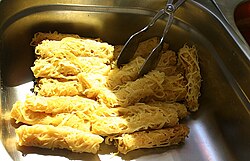Roti jala
 Rolled up roti jala | |
| Alternative names | Roti kirai |
|---|---|
| Type | Pancake |
| Region or state | Sumatra, Riau Islands and Malay Peninsula |
| Associated cuisine | Indonesia,[1] Malaysia, Singapore |


Roti jala, roti kirai or roti renjis (English: net bread or lace pancake; Jawi: روتي جالا) is a popular Malay and Minangkabau tea time snack served with curry dishes which can be found in Indonesia, Malaysia and Singapore.[2] This is a very traditional Malay dish that is usually homemade and served at events such as weddings and festivals. It is usually eaten in sets of three to four pieces with curries, especially chicken curry, as a substitute to rice.[3]
History
Not much is known about the history of roti jala, but it is believed that it first came from India. The recipe was tweaked by locals after arriving in Malaysia. This is why we see similarities between roti jala and ‘putu mayam’ or string hoppers.[4]
The Malays, being originally fishermen and living by the sea, found inspiration for the snack from the nets they used for fishing, thus the name. It is also called roti renjis, which means "Rinsed Bread", because of the original way it was made, which was by hand, in which the ingredient would be 'rinsed' onto the pan to be cooked. roti kirai is another name in which 'kirai' refers to the circular motion of the hand when pouring the ingredient from a condensed milk can with tiny holes poked through it.
Jalara dosa originated from roti jala.[5]
Preparation
The ingredients consist mainly of flour, eggs, milk (dairy or coconut), and a pinch of turmeric. They are combined with water to form a runny batter, then drizzled onto a hot pan in a circular motion. A specialized utensil is often used, resembling a cup with multiple outlets beneath, which aids the creation of the "net-like" effect.
Comparison with string hoppers
While both foods consist of string-like batter, roti jala is made with wheat flour while string hoppers are made with rice flour. Roti jala is made flat in a single layer (then folded or rolled up after cooking, as desired), while string hoppers are made into a small pile. Roti jala is essentially pan-fried, while string hoppers are steamed.
Text is available under the CC BY-SA 4.0 license; additional terms may apply.
Images, videos and audio are available under their respective licenses.
